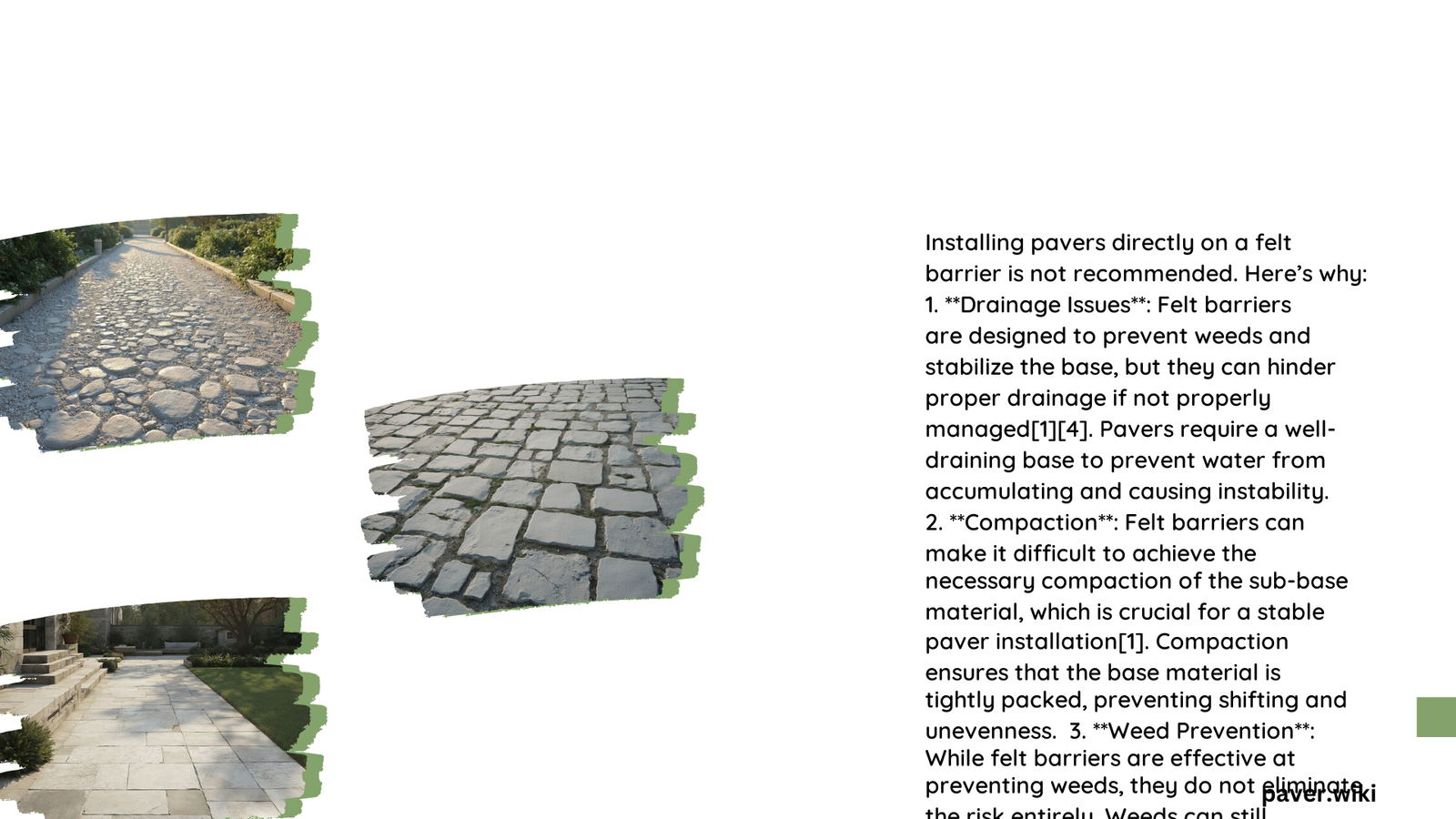Installing pavers on a felt barrier is not recommended due to compatibility issues, lack of structural support, and potential drainage problems. Felt barriers are designed for roofing and wall applications, not for supporting the weight and traffic of pavers. This article explores the reasons why installing pavers on a felt barrier is inadvisable and provides alternative methods for proper paver installation.
Why Is Installing Pavers on a Felt Barrier Not Recommended?
Installing pavers directly on a felt barrier is not a suitable practice for several reasons:
- Structural Incompatibility: Felt barriers lack the necessary strength to support paver weight and traffic.
- Drainage Issues: Felt barriers are not permeable, potentially leading to water accumulation.
- Instability: The lack of a proper base can cause pavers to shift and become unstable over time.
- Premature Failure: Using felt barriers may result in the early deterioration of the paver system.
What Are Felt Barriers Typically Used For?

Felt barriers serve specific purposes in construction, but paver installation is not one of them:
- Roofing Applications: Used as underlayment for shingles and other roofing materials.
- Wall Construction: Serves as a water-resistive barrier in exterior wall systems.
- Moisture Control: Helps prevent moisture penetration in building envelopes.
What Is the Proper Base for Paver Installation?
Instead of a felt barrier, pavers require a specific base structure:
- Compacted Aggregate Base: Provides a stable foundation for the pavers.
- Sand Layer: Helps level the surface and allows for minor adjustments.
- Mortar Setting Bed: Secures the pavers in place.
The mortar setting bed should be:
– Minimum thickness: ⅜ inch (10 mm)
– Maximum thickness: 1½ inches (38 mm)
How Should Pavers Be Properly Installed?
Follow these steps for correct paver installation:
- Prepare the ground by excavating and leveling.
- Install a geotextile fabric to prevent soil migration (optional).
- Add and compact the aggregate base layer.
- Spread and level a layer of bedding sand.
- Install edge restraints to contain the pavers.
- Lay the pavers in the desired pattern.
- Cut pavers as needed to fit the space.
- Compact the pavers to settle them into the bedding sand.
- Spread joint sand and sweep it into the gaps between pavers.
- Compact again to ensure sand fills all joints.
What Are the Risks of Using Felt Barriers for Paver Installation?
Using felt barriers for paver installation can lead to several problems:
| Risk | Consequence |
|---|---|
| Lack of Structural Support | Pavers may sink or become uneven |
| Poor Drainage | Water accumulation leading to damage |
| Instability | Pavers may shift or become loose |
| Reduced Lifespan | Premature failure of the paver system |
| Voided Warranty | Manufacturers may not cover improper installation |
What Materials Are Recommended for Paver Installation?
For a successful paver installation, use these materials:
- Base Material: Crushed stone or gravel (3/4 inch minus)
- Bedding Sand: Coarse, washed sand
- Edge Restraints: Plastic, metal, or concrete
- Joint Sand: Fine, polymeric sand
- Geotextile Fabric: Non-woven landscape fabric (optional)
Are There Any Alternatives to Traditional Paver Installation?
While felt barriers are not suitable, there are alternative paver installation methods:
- Permeable Pavers: Installed over a specialized base for improved drainage.
- Raised Paver Systems: Used on rooftops or over existing concrete.
- Dry-Laid Method: Pavers set on a sand bed without mortar.
- Mortar-Set Method: Pavers adhered directly to a concrete base with mortar.
What Are the Benefits of Proper Paver Installation?
Correctly installing pavers without felt barriers offers numerous advantages:
- Durability: Withstands heavy traffic and weather conditions.
- Proper Drainage: Prevents water accumulation and related issues.
- Stability: Ensures pavers remain level and in place.
- Aesthetic Appeal: Creates a professional, finished look.
- Longevity: Extends the lifespan of the paver system.
- Warranty Compliance: Meets manufacturer specifications for coverage.
In conclusion, installing pavers on a felt barrier is not a recommended or effective practice. Proper paver installation requires specific materials and techniques to ensure durability, stability, and longevity. Always follow manufacturer guidelines and local building codes for the best results in your paver project.
References:
1. Paving Systems Using Clay Pavers in a Mortar Setting Bed
2. Guidance – Flat Roof – Components – Building Regs 4 Plans
3. Brick Veneer Construction: Basics of Resisting Water Penetration in Residential Construction
